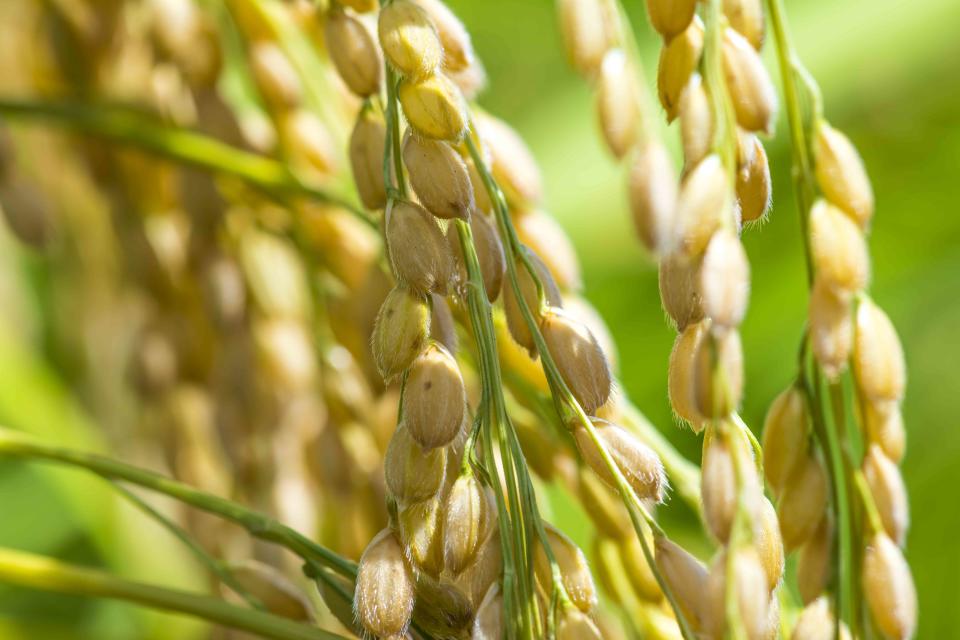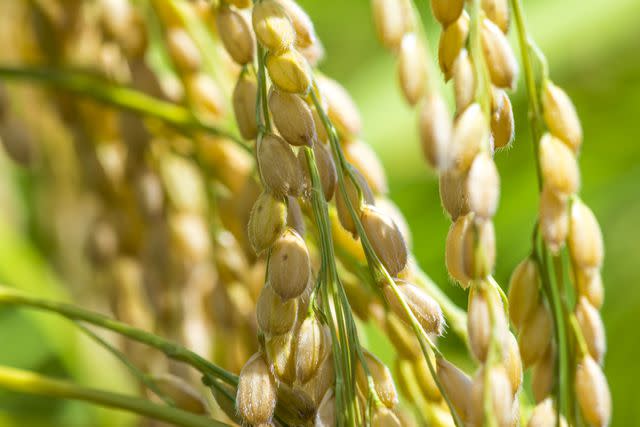How to Plant and Grow Rice
Experiment growing this staple food in containers or in the garden. Enjoy the lovely plant and expect a small harvest.

LITTLE DINOSAUR / Getty Images
Grow rice in the home garden, and you’ll have a much greater appreciation for the steaming bowl of rice that accompanies your next Asian-inspired dish. Rice is an annual grass plant that thrives in Asia and parts of Africa. It will grow in moist, boggy soil, but waterlogged soil is not essential. Most commercial rice is grown in a flooded field, called a paddy, to prevent weed seeds from germinating and overtaking the rice. The rice can tolerate wet conditions, while the weeds cannot. In the home garden, grow rice in wet garden soil or in containers.
Growing this annual grass is relatively easy if you can give it plenty of sunlight and ample water. The labor-intensive aspect of growing rice comes after harvest. The grains must be threshed, de-hulled, and winnowed. After the rice is separated from the plant, the inedible, papery hull must be removed from each grain. Finally, the grain is separated from the chaff in a process called winnowing to produce brown rice.

LITTLE DINOSAUR / Getty Images
Where to Plant Rice
For best growth and weed control, plant rice in wet soil in the landscape or in a container. Unlike most plants, it will grow well in a container without a drainage hole—simply pour off excess water from time to time. Wet, boggy sites, such as soil at the base of a downspout, near a pond edge, or a low-lying spot in your yard, can all be good sites for planting rice. The best planting spot is consistently wet from the beginning of the growing season until late summer.
How and When to Plant Rice
Plant rice in spring as soon as the air temperature moderates and the soil temperature climbs at least 50°F. Plant seed directly into loose soil that is rich in organic matter, or start seed indoors about 6 weeks before the last spring frost. Seedlings will emerge in 5 to 10 days. Transplant seedlings into the garden or a container after all danger of frost is past, making sure to harden off your plants before leaving them outdoors. Thin seedlings to about 6 inches apart in rows 9 to 12 inches apart. Water plants as needed to maintain a moist soil; monitor seedbed closely for weeds. Remove weeds as soon as they are noticed.
Related: 14 Pretty Perennial Plants that Like Wet Soil
Care Tips for Rice
Light
Rice thrives in eight or more hours of direct sunlight a day. Plant it in full sun, away from trees or buildings which can cast shade. Rice planted in part shade will produce weak, floppy stems, and limited grains, and the grain that does develop will be challenging to harvest. Eight or more hours of bright sunlight is essential.
Soil and Water
Rice needs nitrogen-rich soil. Boost soil nitrogen content by incorporating a 4- to 6-inch-thick layer of well-decomposed compost into the soil before seeding. Container-grown rice can be planted in a potting mix enriched with a 4- to 6-inch-thick layer of well-decomposed compost.
Rice thrives with at least an inch of water per week from planting time until the foliage begins to turn yellow at the end of the growing season. Water plants as needed to maintain wet soil, which will decrease weed seed germination.
Related: The 10 Best Compost Bins for Outdoor, Indoor, and Kitchen Countertop Use
Temperature and Humidity
Rice grows best in areas with high summer temperatures and high humidity. It doesn’t tolerate frost and grows slowly in cool temperatures. Generally, rice grows best in Zone 7 and higher and in areas that receive frequent rainfall.
Fertilizer
Provide nitrogen during the growing season by fertilizing plants with fish emulsion if desired. Follow package directions for timing and the amount of product to apply. A 4- to 6-inch-thick layer of compost spread over the soil at planting time is another excellent source of fertilizer.
Harvesting
Rice is ready to harvest when the seed head is yellow and dry. Cut the stem just below the seed head and allow the seed head to dry further in a protected location such as a garage. Save the seed for the following year by rubbing the seed head between your hands to dislodge the individual grains. Store the dry grain in an airtight container until planting the following spring.
Preparing rice for consumption is a labor of love. First, the individual grains must be separated from the stem. Pull your hand along each individual stem to dislodge the dry grains. Next, the papery husk must be removed from each grain. Home gardeners have developed several labor-intensive ways to remove the husk; try a few different methods to find the best fit for you. After the husk is removed, a brown coating, called bran, will be visible on the grain. Rice at this point in the milling process is called brown rice and is edible. Several more processes need to be executed to remove the bran and create white rice.
Pests and Problems
Weeds are the biggest threat to young rice plants. Grassy weeds spring up alongside rice and will overtake the grain in short order. Maintain a weed-free planting plot by flooding the area with water from time to time until plants are at least 12 inches tall. Birds love rice. Protect mature seed heads by covering plants with bird netting.
How to Propagate Rice
Rice is easy to grow from seeds saved from the previous year’s crop. Store the dry grain in an airtight container until planting the following spring.
Related: 8 Flavorful Rice Recipes to Complete Your Dinner Menu
Types of Rice
‘Carolina Gold’ is a long-grain brown rice that has a nutty flavor and a chewy texture. Grown for more than two centuries in the Southeast United States, ‘Carolina Gold’ is available from heirloom seed suppliers.
‘Charleston Gold’ is like ‘Carolina Gold’ in flavor and texture, but the overall plants are shorter. These smaller plants are less likely to bend and fall in storms.
‘Hmong Sticky’ is a traditional Asian variety that yields a good harvest from 4 to 5 feet tall plants.
Frequently Asked Questions
Can I start rice from grain purchased at the grocery store?
No. Rice from the grocery store is highly processed and will not germinate. Purchase rice seed from a trusted source. There are a few online seed sources.
Can rice be grown indoors?
Yes, rice can be grown indoors, but it’s unlikely it will mature completely to harvest a substantial crop. For best results, grow rice outdoors.
Does rice grow well in a pot?
Yes, rice thrives in containers. It can even be grown in a container that does not have a drainage hole. Simply water it and gently pour off the excess water from time to time.
For more Better Homes & Gardens news, make sure to sign up for our newsletter!
Read the original article on Better Homes & Gardens.
